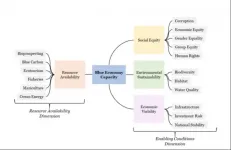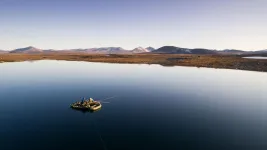(Press-News.org) London, UK (17 March 2021)--A new study published in the prestigious peer-reviewed scientific journal Nature today offers a combined solution to several of humanity's most pressing challenges. It is the most comprehensive assessment to date of where strict ocean protection can contribute to a more abundant supply of healthy seafood and provide a cheap, natural solution to address climate change--in addition to protecting embattled species and habitats.
An international team of 26 authors identified specific areas that, if protected, would safeguard over 80% of the habitats for endangered marine species, and increase fishing catches by more than eight million metric tons. The study is also the first to quantify the potential release of carbon dioxide into the ocean from trawling, a widespread fishing practice--and finds that trawling is pumping hundreds of millions of tons of carbon dioxide into the ocean every year, a volume of emissions similar to those of aviation.
"Ocean life has been declining worldwide because of overfishing, habitat destruction and climate change. Yet only 7% of the ocean is currently under some kind of protection," said Dr. Enric Sala, explorer in residence at the National Geographic Society and lead author of the study, Protecting the global ocean for biodiversity, food and climate.
"In this study, we've pioneered a new way to identify the places that--if strongly protected--will boost food production and safeguard marine life, all while reducing carbon emissions," Dr. Sala said. "It's clear that humanity and the economy will benefit from a healthier ocean. And we can realize those benefits quickly if countries work together to protect at least 30% of the ocean by 2030."
To identify the priority areas, the authors--leading marine biologists, climate experts, and economists--analyzed the world's unprotected ocean waters based on the degree to which they are threatened by human activities that can be reduced by marine protected areas (for example, overfishing and habitat destruction). They then developed an algorithm to identify those areas where protections would deliver the greatest benefits across the three complementary goals of biodiversity protection, seafood production and climate mitigation. They mapped these locations to create a practical "blueprint" that governments can use as they implement their commitments to protect nature.
The study does not provide a single map for ocean conservation, but it offers a first-in-kind framework for countries to decide which areas to protect depending on their national priorities. However, the analysis shows that 30% is the minimum amount of ocean that the world must protect in order to provide multiple benefits to humanity.
"There is no single best solution to save marine life and obtain these other benefits. The solution depends on what society--or a given country--cares about, and our study provides a new way to integrate these preferences and find effective conservation strategies," said Dr. Juan S. Mayorga, a report co-author and a marine data scientist with the Environmental Market Solutions Lab at UC Santa Barbara and Pristine Seas at National Geographic Society.
The study comes ahead of the 15th Conference of the Parties to the United Nations Convention on Biological Diversity, which is expected to take place in Kunming, China in 2021. The meeting will bring together representatives of 190 countries to finalize an agreement to end the world's biodiversity crisis. The goal of protecting 30% of the planet's land and ocean by 2030 (the "30x30" target) is expected to be a pillar of the treaty. The study follows commitments by the United States, the United Kingdom, Canada, the European Commission and others to achieve this target on national and global scales.
Safeguarding Biodiversity
The report identifies highly diverse marine areas in which species and ecosystems face the greatest threats from human activities. Establishing marine protected areas (MPAs) with strict protection in those places would safeguard more than 80% of the ranges of endangered species, up from a current coverage of less than 2%.
The authors found that the priority locations are distributed throughout the ocean, with the vast majority of them contained within the 200-mile Exclusive Economic Zones of coastal nations.
The additional protection targets are located in the high seas--those waters governed by international law. These include the Mid-Atlantic Ridge (a massive underwater mountain range), the Mascarene Plateau in the Indian Ocean, the Nazca Ridge off the west coast of South America and the Southwest Indian Ridge, between Africa and Antarctica.
"Perhaps the most impressive and encouraging result is the enormous gain we can obtain for biodiversity conservation--if we carefully chose the location of strictly protected marine areas," said Dr. David Mouillot, a report co-author and a professor at the Université de Montpellier in France. "One notable priority for conservation is Antarctica, which currently has little protection, but is projected to host many vulnerable species in a near future due to climate change."
Shoring up the Fishing Industry
The study finds that smartly placed marine protected areas (MPAs) that ban fishing would actually boost the production of fish--at a time when supplies of wild-caught fish are dwindling and demand is rising. In doing so, the study refutes a long-held view that ocean protection harms fisheries and opens up new opportunities to revive the industry just as it is suffering from a recession due to overfishing and the impacts of global warming.
"Some argue that closing areas to fishing hurts fishing interests. But the worst enemy of successful fisheries is overfishing--not protected areas," Dr. Sala said.
The study finds that protecting the right places could increase the catch of seafood by over 8 million metric tons relative to business as usual.
"It's simple: When overfishing and other damaging activities cease, marine life bounces back," said Dr. Reniel Cabral, a report co-author and assistant researcher with the Bren School of Environmental Science & Management and Marine Science Institute at UC Santa Barbara. "After protections are put in place, the diversity and abundance of marine life increase over time, with measurable recovery occurring in as little as three years. Target species and large predators come back, and entire ecosystems are restored within MPAs. With time, the ocean can heal itself and again provide services to humankind."
Soaking up Carbon
The study is the first to calculate the climate impacts of bottom trawling, a damaging fishing method used worldwide that drags heavy nets across the ocean floor. It finds that the amount of carbon dioxide released into the ocean from this practice is larger than most countries' annual carbon emissions, and similar to annual carbon dioxide emissions from global aviation.
"The ocean floor is the world's largest carbon storehouse. If we're to succeed in stopping global warming, we must leave the carbon-rich seabed undisturbed. Yet every day, we are trawling the seafloor, depleting its biodiversity and mobilizing millennia-old carbon and thus exacerbating climate change. Our findings about the climate impacts of bottom trawling will make the activities on the ocean's seabed hard to ignore in climate plans going forward," said Dr. Trisha Atwood of Utah State University, a co-author of the paper.
The study finds that countries with the highest potential to contribute to climate change mitigation via protection of carbon stocks are those with large national waters and large industrial bottom trawl fisheries. It calculates that eliminating 90% of the present risk of carbon disturbance due to bottom trawling would require protecting only about 4% of the ocean, mostly within national waters.
Closing a Gap
The study's range of findings helps to close a gap in our knowledge about the impacts of ocean conservation, which to date had been understudied relative to land-based conservation.
"The ocean covers 70% of the earth--yet, until now, its importance for solving the challenges of our time has been overlooked," said Dr. Boris Worm, a study co-author and Killam Research Professor at Dalhousie University in Halifax, Nova Scotia. "Smart ocean protection will help to provide cheap natural climate solutions, make seafood more abundant and safeguard imperiled marine species--all at the same time. The benefits are clear. If we want to solve the three most pressing challenges of our century--biodiversity loss, climate change and food shortages --we must protect our ocean."
Additional Quotes from Supporters and Report Co-Authors
Zac Goldsmith, British Minister for Pacific and the Environment, UK
"This paper is an important contribution to the science on ocean protection and highlights the need for countries to work together to protect at least 30% of the global ocean by 2030. In the UK we are at the forefront of marine protection, and are leading the Global Ocean Alliance of more than forty nations supporting this 30 by 30 target. We will do all we can to deliver it at the UN biodiversity conference in China."
Dr. Ben Halpern, Director of the National Center for Ecological Analysis and Synthesis (NCEAS), UCSB
"Our research is a bit like building a race car. We didn't just look at how to put the best tires on the car and then install a lawnmower motor, or design an aerodynamic shell but then add wooden wheels. By looking at three different conservation objectives at once, we could find a design that produced a Formula 1 outcome for the oceans."
Kristen Rechberger, Founder & CEO, Dynamic Planet:
"The ocean's vast natural capital has been squandered for far too long. Our study shows that more ocean protection yields greater economic benefit and even opens up a new carbon market to help reach climate and nature goals. As the world pushes for a net-zero economy by 2050, and needs nature restored to get there, this study comes at the perfect time and shows where to invest."
Dr. William Chueng, Canada Research Chair and Professor, The University of British Columbia, Principal Investigator, Changing Ocean Research Unit, The University of British Columbia
"Now we have solid evidence that fully protecting over 30% of the ocean will be great for conserving fish stocks, improving fisheries production and helping to tackle climate change. The ocean will greatly benefit from an international agreement with clear ambitions for protection, similar to having the Paris Agreement to set the global warming target for climate actions "
Dr. Jennifer McGowan, Spatial Planning Technical Coordinator, The Nature Conservancy & Research Associate, Jetz Lab, Yale University
"Science shows us how, political will tells us when. The 'when' has to be now as we simply cannot allow the ocean to fail. This research sets the foundation for the next era of ocean conservation to be one that truly places biodiversity and people at the heart of national conversations. As the world prepares to set the global agenda for the next decade of climate and biodiversity policy, this research provides the bedrock upon which decisions-makers can map and plan interactions with the ocean to deliver multiple benefits for people and biodiversity. Our research provides evidence that the time has come to retire the narrative that conservation is at odds with economic prosperity. This must be the time to build prosperous and sustainable ocean economies and this research points out how to do that."
Dr. Alan Friedlander, Chief Scientist, Pristine Seas, National Geographic Society at the Hawai'i Institute of Marine Biology, University of Hawai'i
"By identifying where and how much of the ocean to protect, we can insure a sustainable planet well into the future. Healthy oceans are essential to our existence and this work clearly identifies where and how much to protect for the maximum benefit to people. This framework identifies how much of the ocean to protect to maximize the benefits to humanity."
Dr. Whitney Goodell, Marine Ecologist, Pristine Seas, National Geographic Society
"The ocean is critical to global biodiversity, food security, and climate change mitigation. Ocean protection can be planned in a way to maximize the multiple benefits, and coordinated global efforts to do so can be substantially more efficient than isolated national efforts. For humanity to continue benefiting from the ocean, we must think and act globally, and maximize our efforts."
Dr. Lance Morgan, President and CEO, Marine Conservation Institute
"As the world focuses on a bold agenda to protect 30% of nature by 2030 these results provide a roadmap for conservation efforts aimed at healthier future for nature and humankind."
Dr. Darcy Bradley, Co-Director of the Ocean and Fisheries Program at the Environmental Market Solutions Lab, UCSB
"While we consider three key benefits that marine protection is known to confer, this is really just the beginning. Our approach is a way to bring multiple stakeholders to the table, to show that their interests can be prioritized, and ultimately to demonstrate that solutions that protect large ocean areas and benefit multiple simultaneous objectives exist."
INFORMATION:
One of the best ways to study human evolution is by comparing us with nonhuman species that, evolutionarily speaking, are closely related to us. That closeness can help scientists narrow down precisely what makes us human, but that scope is so narrow it can also be extremely hard to define. To address this complication, researchers from Stanford University have developed a new technique for comparing genetic differences.
Through two separate sets of experiments with this technique, the researchers discovered new genetic differences between humans and chimpanzees. They found a significant ...
Stopping the spread of political misinformation on social media may seem like an impossible task. But a new study co-authored by MIT scholars finds that most people who share false news stories online do so unintentionally, and that their sharing habits can be modified through reminders about accuracy.
When such reminders are displayed, it can increase the gap between the percentage of true news stories and false news stories that people share online, as shown in online experiments that the researchers developed.
"Getting people to think about accuracy makes them more discerning in their sharing, regardless of ideology," says MIT professor David Rand, co-author of a newly published paper detailing the results. "And it translates ...
Among adults with children living in the home, cannabis use was more common in states with legalized cannabis use, according to a new study by Columbia University Mailman School of Public Health, Columbia Irving Medical Center and the City University of New York. Legalization for recreational and medical use were both linked with significantly higher prevalence of past-month and daily cannabis use. Until now, most tobacco control and harm reduction efforts protecting youth from exposure to secondhand tobacco smoke focused on parental cigarette smoking, ensuring smoke-free homes, and not smoking in the presence of children. The findings are published ...
The future of an equitable and sustainable global ocean, or "Blue Economy," depends on more than the resources available for technological advancement and industry expansion. A recent UBC-led study found that socioeconomic and governance conditions such as national stability, corruption and human rights greatly affect the ability to achieve a Blue Economy.
The study, published today in Nature, scored criteria across five global regions: Africa, Americas, Asia, Europe and Oceania, to identify the areas of investment and research necessary to develop ocean resources in a manner that is consistent with a Blue Economy ethos (socially ...
To observe how a tiny ball of identical cells on its way to becoming a mammalian embryo first attaches to an awaiting uterine wall and then develops into nervous system, heart, stomach and limbs: This has been a highly-sought grail in the field of embryonic development for nearly 100 years. Prof. Jacob Hanna of the Weizmann Institute of Science and his group have now accomplished this feat. The method they created for growing mouse embryos outside the womb during the initial stages after embryo implantation will give researchers an unprecedented tool for understanding the development program encoded in the genes, and it may provide detailed insight into birth and developmental defects as well as those involved ...
Forces acting inside the Earth have been constantly reshaping the continents and ocean basins over millions of years. What Alfred Wegener published as an idea in 1915 has finally been accepted since the 1960s, providing a unifying view about our planet. The fact that the theory of plate tectonics took so long to gain acceptance had two simple reasons. First, the geological formations that are most important for its understanding lie at the bottom of the oceans. Secondly, forces controlling the processes act below the seafloor and are hence hidden from our view. Many details of plate tectonics are therefore still unclear today.
Today, ...
Tucson, Ariz. (March 16, 2021) - This week, a new, peer-reviewed scientific study finds that there is far more potential jaguar habitat in the U.S. than was previously thought. Scientists identified an area of more than 20 million acres that could support jaguars in the U.S., 27 times the size of designated critical habitat.
The results, published in the journal Oryx, are based on a review of 12 habitat models for jaguars within Arizona and New Mexico, conclusively identifying areas suitable for the recovery of these wild cats. Based on the expanded habitat area, the authors conclude that findings uncover new opportunities for jaguar conservation in North America that ...
Researchers have channeled the universe's earliest light - a relic of the universe's formation known as the cosmic microwave background (CMB) - to solve a missing-matter mystery and learn new things about galaxy formation. Their work could also help us to better understand dark energy and test Einstein's theory of general relativity by providing new details about the rate at which galaxies are moving toward us or away from us.
Invisible dark matter and dark energy account for about 95% of the universe's total mass and energy, and the majority of the 5% that is considered ordinary matter is also largely unseen, such as the gases at the outskirts of galaxies that comprise their so-called halos.
Most ...
Imagine not a white, but a green Arctic, with woody shrubs as far north as the Canadian coast of the Arctic Ocean. This is what the northernmost region of North America looked like about 125,000 years ago, during the last interglacial period, finds new research from the University of Colorado Boulder.
Researchers analyzed plant DNA more than 100,000 years old retrieved from lake sediment in the Arctic (the oldest DNA in lake sediment analyzed in a publication to date) and found evidence of a shrub native to northern Canadian ecosystems 250 miles (400 km) farther north than its current range.
As the Arctic warms much ...
An estimated 14,480 new cases of invasive cervical cancer will be diagnosed in the United States this year, according to the American Cancer Society. Cases that could be prevented or cured with better education from screening to treatment based on improved provider-patient communication, says a Michigan State University researcher.
The issue is particularly acute for Black women, said Sabrina Ford, an associate professor in the Department of Obstetrics, Gynecology and Reproductive Biology within MSU's College of Human Medicine. Ford's research was published ...



